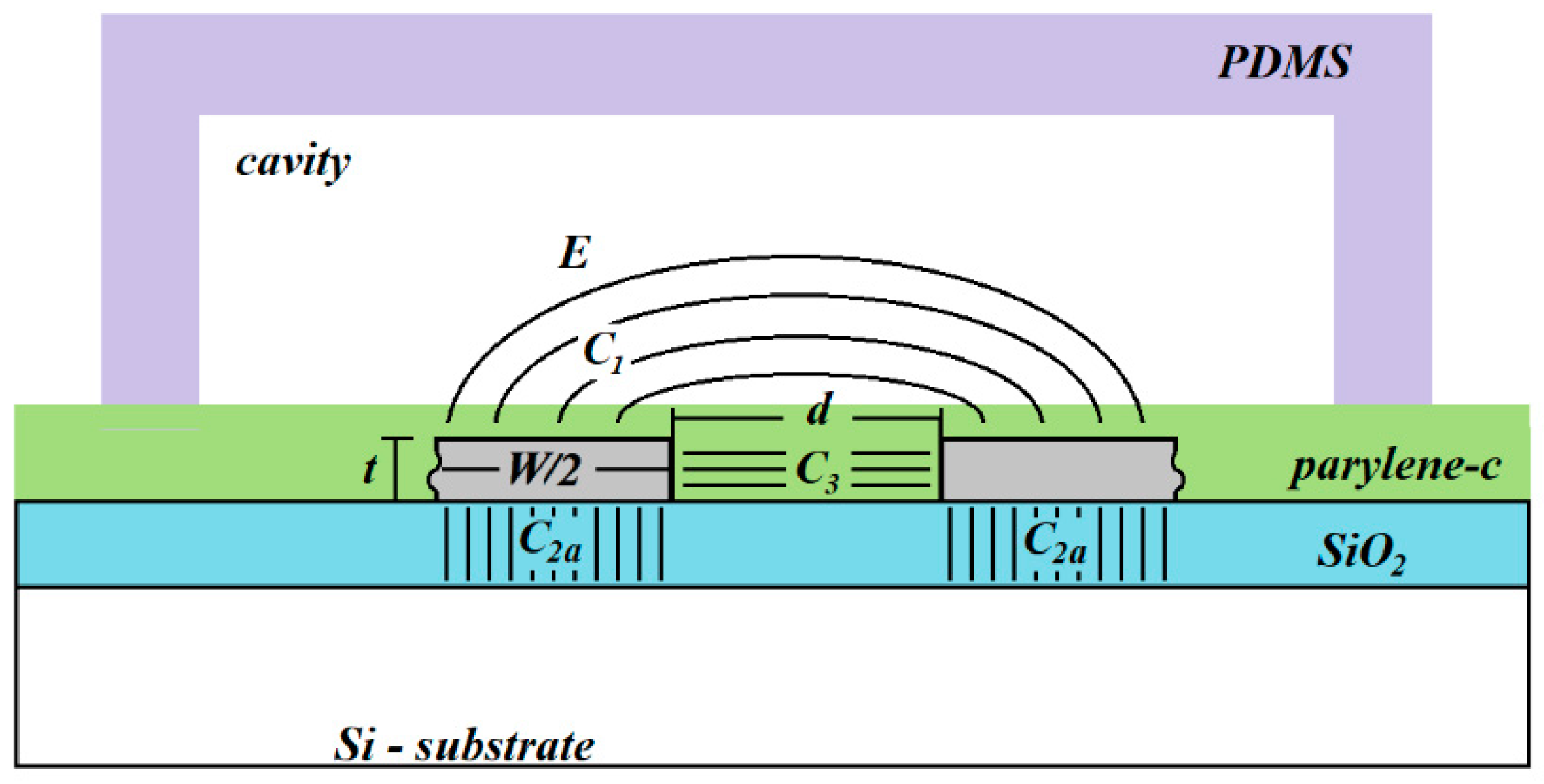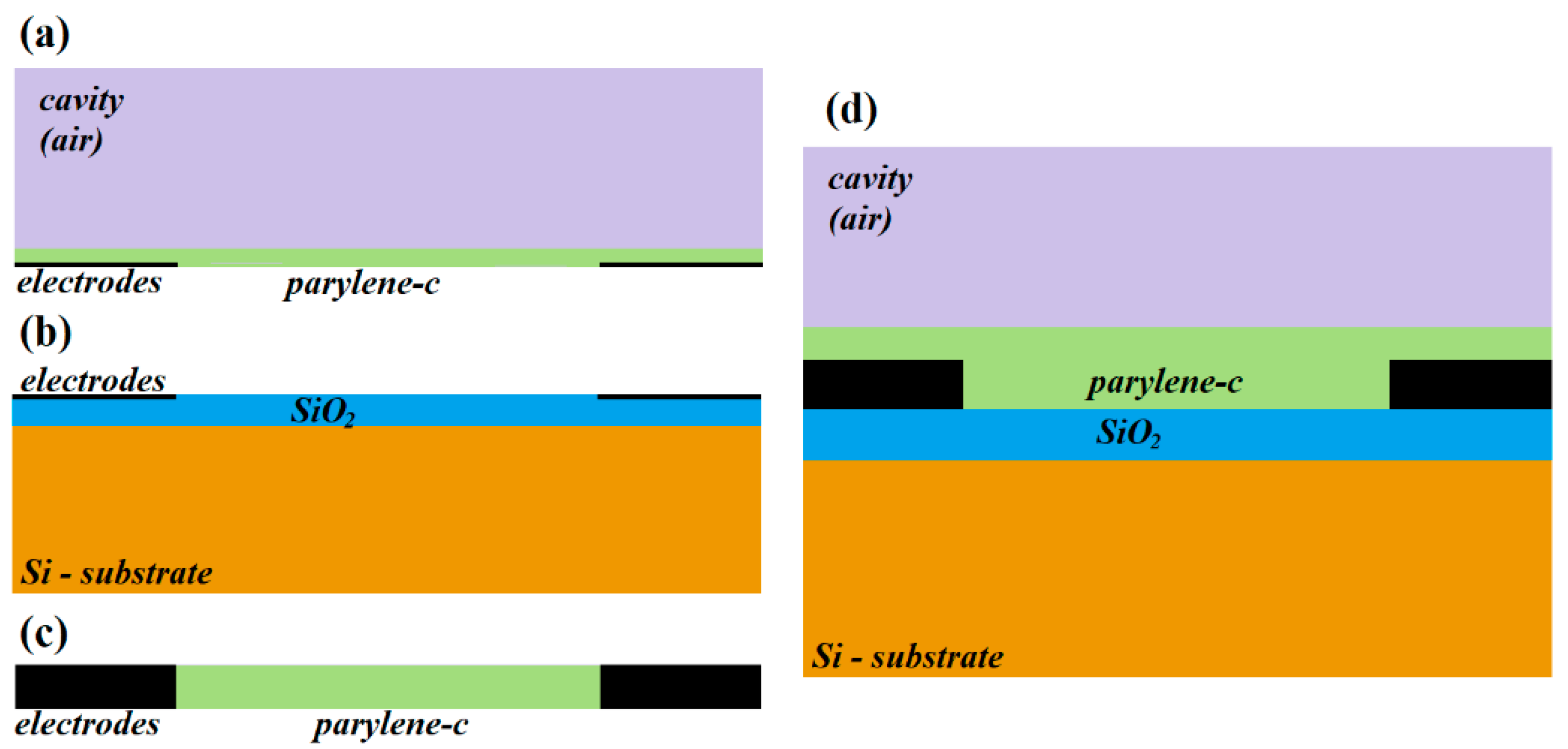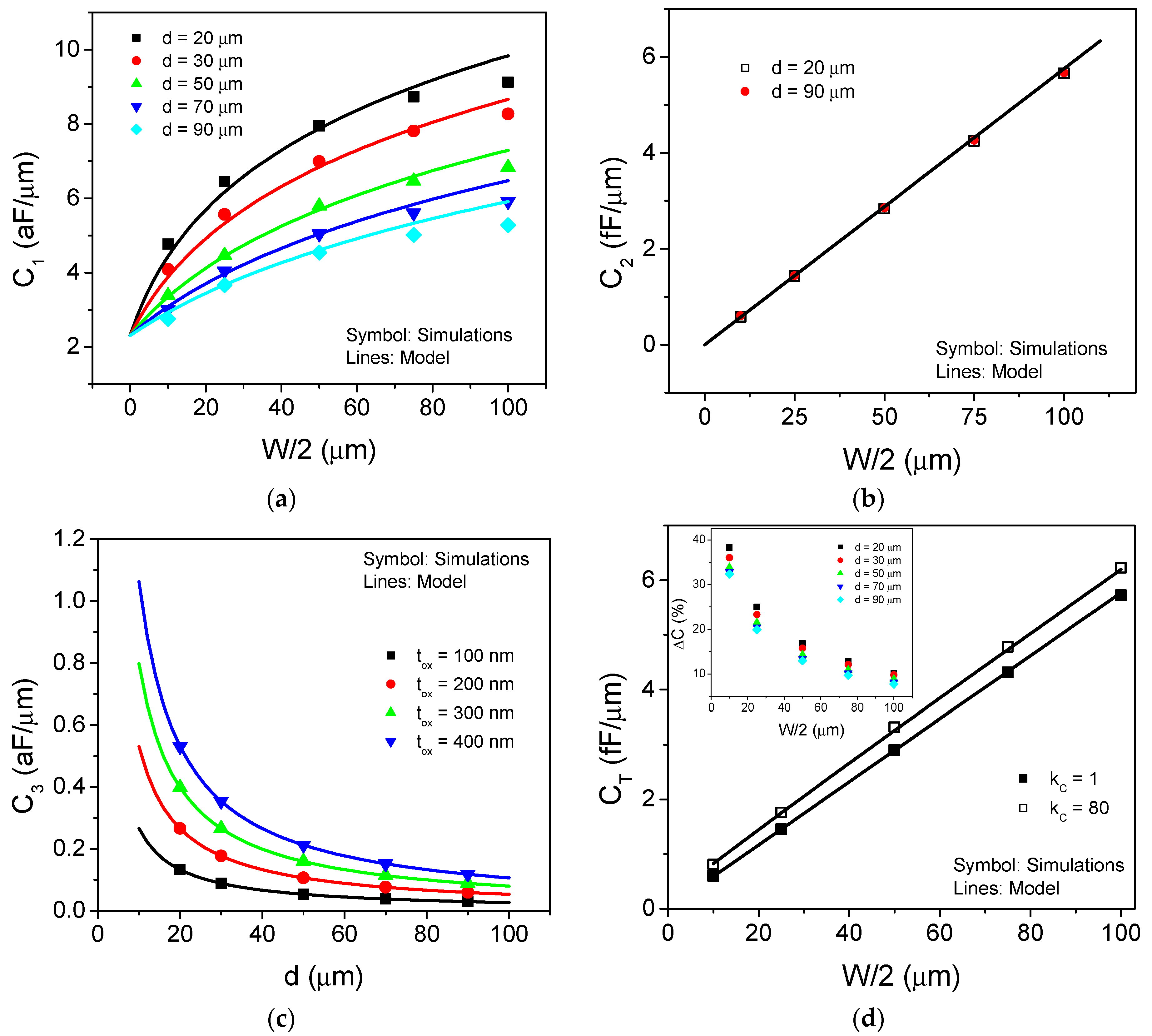Silicon Based Coplanar Capacitive Device for Liquid Sensor Applications
Abstract
:1. Introduction
2. Coplanar Capacitive Sensor
2.1. Fabrication Process
2.2. Sensor Physical Implementation
3. Sensor Model
3.1. Capacitive Component C1
3.2. Capacitive Component C2
3.3. Capacitive Component C3
3.4. Total Capacitive Sensor Model
4. Simulation Results
5. Experimental Results
6. Conclusions
Author Contributions
Funding
Institutional Review Board Statement
Informed Consent Statement
Data Availability Statement
Acknowledgments
Conflicts of Interest
References
- Amin, S.U.; Hossain, M.S.; Muhammad, G.; Alhussein, M.; Rahman, A. Cognitive Smart Healthcare for Pathology Detection and Monitoring. IEEE Access 2019, 7, 10745–10753. [Google Scholar] [CrossRef]
- Hubl, M.; Pohl, O.; Noack, V.; Hahlweg, P.; Ehm, C.; Derleh, M.; Weiland, T.; Schick, E.; Muller, H.-H.; Hampicke, D.; et al. Embedding of wearable electronics into smart sensor insole. In Proceedings of the 2016 IEEE 18th Electronics Packaging Technology Conference (EPTC), Singapore, 30 November–3 December 2016; pp. 597–601. [Google Scholar]
- Meah, K.; Forsyth, J.; Moscola, J. A Smart Sensor Network for an Automated Urban Greenhouse. In Proceedings of the 2019 International Conference on Robotics, Electrical and Signal Processing Techniques (ICREST), Dhaka, Bangladesh, 10–12 January 2019; pp. 23–27. [Google Scholar]
- Xiong, Y.; Shen, Y.; Tian, L.; Hu, Y.; Zhu, P.; Sun, R.; Wong, C.-P. A flexible, ultra-highly sensitive and stable capacitive pressure sensor with convex microarrays for motion and health monitoring. Nano Energy 2020, 70, 104436. [Google Scholar] [CrossRef]
- Jang, M.; Yun, K.-S. MEMS capacitive pressure sensor monolithically integrated with CMOS readout circuit by using post CMOS processes. Micro Nano Syst. Lett. 2017, 5, 164. [Google Scholar] [CrossRef] [Green Version]
- Wei, Q.; Kim, M.-J.; Lee, J.-H. Development of capacitive sensor for automatically measuring tumbler water level with FEA simulation. Technol. Health Care 2018, 26, 491–500. [Google Scholar] [CrossRef]
- Zulfiqar, M.H.; Saleem, M.M.; Zubair, M.; Mehmood, M.Q.; Riaz, K. Foldable, Eco-Friendly and Low-Cost Microfluidic Paper-Based Capacitive Droplet Sensor. In Proceedings of the 2020 International Conference on UK-China Emerging Technologies (UCET), Glasgow, UK, 20–21 August 2020; pp. 1–4. [Google Scholar]
- Atalay, O.; Atalay, A.; Gafford, J.; Walsh, C. A Highly Sensitive Capacitive-Based Soft Pressure Sensor Based on a Conductive Fabric and a Microporous Dielectric Layer. Adv. Mater. Technol. 2018, 3, 1700237. [Google Scholar] [CrossRef]
- Hsieh, M.-L.; Yeh, S.-K.; Lee, J.-H.; Cheng, M.-C.; Fang, W. CMOS-MEMS capacitive tactile sensor with vertically integrated sensing electrode array for sensitivity enhancement. Sens. Actuators A Phys. 2021, 317, 112350. [Google Scholar] [CrossRef]
- Masanori, M.; Muroyama, M.; Nakayama, T.; Hata, Y.; Nonomura, Y.; Tanaka, S. 3-Axis Fully-Integrated Capacitive Tactile Sensor with Flip-Bonded CMOS on LTCC Interposer. Sensors 2017, 17, 2451. [Google Scholar] [CrossRef]
- Mamishev, A.; Sundara-Rajan, K.; Yang, F.; Du, Y.; Zahn, M. Interdigital sensors and transducers. Proc. IEEE 2004, 92, 808–845. [Google Scholar] [CrossRef] [Green Version]
- Rivadeneyra, A.; Salmerón, J.F.; Banqueri, J.; Villanueva, J.A.L.; Capitan-Vallvey, L.F.; Palma, A.J. A novel electrode structure compared with interdigitated electrodes as capacitive sensor. Sens. Actuators B Chem. 2014, 204, 552–560. [Google Scholar] [CrossRef]
- Pietrikova, A.; Zuk, S.; Vehec, I. Coplanar Capacitive Liquid Level Sensor. In Proceedings of the 2019 42nd International Spring Seminar on Electronics Technology (ISSE), Wroclaw, Poland, 15–19 May 2019; pp. 1–6. [Google Scholar]
- Dong, T.; Barbosa, C. Capacitance Variation Induced by Microfluidic Two-Phase Flow across Insulated Interdigital Electrodes in Lab-On-Chip Devices. Sensors 2015, 15, 2694–2708. [Google Scholar] [CrossRef] [PubMed] [Green Version]
- Chen, J.Z.; Darhuber, A.; Troian, S.M.; Wagner, S. Capacitive sensing of droplets for microfluidic devices based on thermocapillary actuation. Lab Chip 2004, 4, 473–480. [Google Scholar] [CrossRef] [PubMed] [Green Version]
- Su, Y.; Wang, J.; Wang, B.; Yang, T.; Yang, B.; Xie, G.; Zhou, Y.; Zhang, S.; Tai, H.; Cai, Z.; et al. Alveolus-Inspired Active Membrane Sensors for Self-Powered Wearable Chemical Sensing and Breath Analysis. ACS Nano 2020, 14, 6067–6075. [Google Scholar] [CrossRef] [PubMed]
- Cholleti, E.R.; Stringer, J.; Assadian, M.; Battmann, V.; Bowen, C.; Aw, K. Highly Stretchable Capacitive Sensor with Printed Carbon Black Electrodes on Barium Titanate Elastomer Composite. Sensors 2018, 19, 42. [Google Scholar] [CrossRef] [PubMed] [Green Version]
- Xie, L.; Chen, P.; Chen, S.; Yu, K.; Sun, H. Low-Cost and Highly Sensitive Wearable Sensor Based on Napkin for Health Monitoring. Sensors 2019, 19, 3427. [Google Scholar] [CrossRef] [PubMed] [Green Version]






Publisher’s Note: MDPI stays neutral with regard to jurisdictional claims in published maps and institutional affiliations. |
© 2021 by the authors. Licensee MDPI, Basel, Switzerland. This article is an open access article distributed under the terms and conditions of the Creative Commons Attribution (CC BY) license (https://creativecommons.org/licenses/by/4.0/).
Share and Cite
Martinez-Lopez, A.G.; Guzmán-Caballero, D.E.; Mejia, I.; Tinoco, J.C. Silicon Based Coplanar Capacitive Device for Liquid Sensor Applications. Sensors 2021, 21, 5958. https://doi.org/10.3390/s21175958
Martinez-Lopez AG, Guzmán-Caballero DE, Mejia I, Tinoco JC. Silicon Based Coplanar Capacitive Device for Liquid Sensor Applications. Sensors. 2021; 21(17):5958. https://doi.org/10.3390/s21175958
Chicago/Turabian StyleMartinez-Lopez, Andrea G., David E. Guzmán-Caballero, Israel Mejia, and Julio C. Tinoco. 2021. "Silicon Based Coplanar Capacitive Device for Liquid Sensor Applications" Sensors 21, no. 17: 5958. https://doi.org/10.3390/s21175958
APA StyleMartinez-Lopez, A. G., Guzmán-Caballero, D. E., Mejia, I., & Tinoco, J. C. (2021). Silicon Based Coplanar Capacitive Device for Liquid Sensor Applications. Sensors, 21(17), 5958. https://doi.org/10.3390/s21175958





